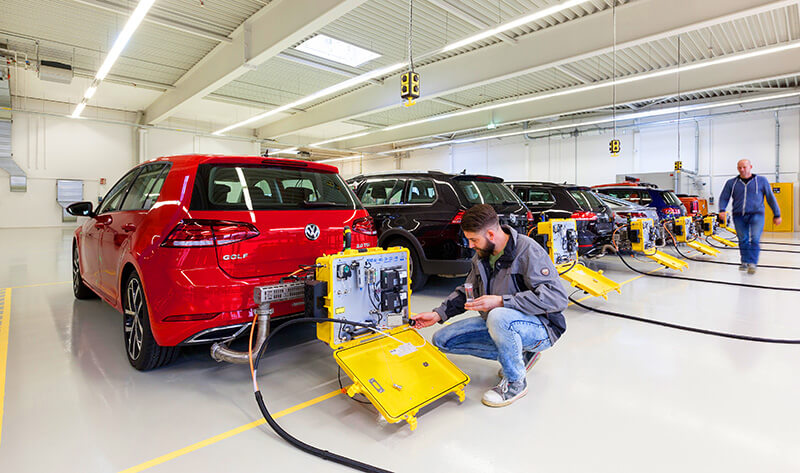 The start of September this year marked the point at which all new car registrations in the EU had to comply with the new CO2 emissions test – the Worldwide Harmonised Light Vehicle Test Procedure (WLTP). This laboratory test is designed to introduce more realistic and stricter criteria when assessing CO2 emissions, including higher average and maximum speeds, longer test distances and a greater range of driving situations. It has been introduced to counter widely acknowledged deficiencies in the previous NEDC (New European Driving Cycle) test, which was designed in the 1980s and last updated in 1997.
The start of September this year marked the point at which all new car registrations in the EU had to comply with the new CO2 emissions test – the Worldwide Harmonised Light Vehicle Test Procedure (WLTP). This laboratory test is designed to introduce more realistic and stricter criteria when assessing CO2 emissions, including higher average and maximum speeds, longer test distances and a greater range of driving situations. It has been introduced to counter widely acknowledged deficiencies in the previous NEDC (New European Driving Cycle) test, which was designed in the 1980s and last updated in 1997.
Vehicle-makers will have to publish WLTP-measured fuel consumption figures for all new vehicles from January 1 2019 and will be required to meet stringent new CO2 emissions targets 12 months later. While vehicles made in all 28 EU markets need to be WLTP type-approved, the starting point of legally binding communication of WLTP consumption and CO2 values is determined individually by national legislators.
Speaking earlier this year at a meeting of the Association of European Vehicle Logistics (ECG), Justin Cox, director of global production for market intelligence provider, LMC Automotive, said there was great variation in national adoption. Cox said it ranged from “non-existent” in the case of Italy, where vehicle taxation is not emissions-related, to “severe” in the case of the Netherlands, Norway and Denmark, with registration taxation depending heavily on emissions in the first two and on fuel economy in the third.
Carmakers have had to respond quickly to the new legislation, which was only approved for implementation in July this year, and international sales organisations are being primed for the changes in advance, according to a number of carmakers. The hope in certain quarters that the deadline could be postponed into next year came to nothing – perhaps reflecting how the relationship between government and the automotive industry has suffered in the wake of the diesel scandal.
While most carmakers say they are ready for this, current forecasts suggest that they will struggle to meet the next CO2 emissions target of 95g/km when it is phased in during 2020 and will face fines for not doing so. Industry analyst IHS Markit says carmakers failing to meet the 2021 targets could be fined more than €14 billion ($16.1 billion).
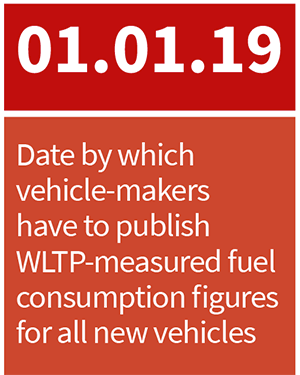 What has been an even more immediate challenge from a logistics point of view is the stress on production and distribution, including longer lead times resulting from the introduction of the new tests, and the need to find additional storage space for vehicles awaiting certification. Ford, for example, says vehicle development times are increasing because of the new regulation, regardless of whether they are made inside or outside the EU, though it has been able to incorporate the additional time required to avoid delivery issues.
What has been an even more immediate challenge from a logistics point of view is the stress on production and distribution, including longer lead times resulting from the introduction of the new tests, and the need to find additional storage space for vehicles awaiting certification. Ford, for example, says vehicle development times are increasing because of the new regulation, regardless of whether they are made inside or outside the EU, though it has been able to incorporate the additional time required to avoid delivery issues.
Storing up troubleVolkswagen has been one of the hardest hit by the swift introduction of the regulation, not least because its engineers were already preoccupied with attempting to remedy diesel engines with software and hardware upgrades in the wake of ‘dieselgate’.
VW’s Thomas Zahn, head of sales and marketing in Germany, said in August that the transition to the WLTP test procedure would lead to lengthier delivery times. He said this would vary from case to case, depending on the precise order time and the approval for the respective engine-gearbox variant.
“If there is already WLTP approval, then there will be no impact. In other cases, delivery times could be delayed by weeks or months,” he said. More than 80% of the temporarily stored cars are pre-ordered vehicles that have already been sold to customers.
VW has been producing vehicles that comply with WLTP requirements since the beginning of August and they have had to wait for approval by the authorities. Zahn said there would be delays, particularly during September and part of October.
“However, we are still convinced that this can be offset by the end of the year,” he said in a statement earlier this year. “That means that we are expecting an extremely high amount of deliveries for November and December.”
In the same month, VW announced that to keep waiting times as short as possible for customers, it was using the systematic storage of vehicles at a variety of locations, including the new airport in Berlin.
 "If there is already WLTP approval [on particular models], then there will be no impact. In other cases, delivery times could be delayed by weeks or months." - Thomas Zahn, Volkswagen
"If there is already WLTP approval [on particular models], then there will be no impact. In other cases, delivery times could be delayed by weeks or months." - Thomas Zahn, Volkswagen
The OEM also announced closures in production beyond the works holidays as a result of the changeover to the WLTP test cycle, to control excess volumes in storage. Earlier in June, Herbert Diess, chairman of the board of management of the Volkswagen Group and the VW brand, said vehicles would be delivered step-by-step as soon as the type-approvals required were available.
“Nevertheless, we will need to store a large number of vehicles on an interim basis,” he said. “To ensure that this number does not become too large, we will need to plan closure days for production in Wolfsburg during the period between the works holidays and the end of September.”
Industry insiders put the number of vehicles affected at around 250,000, and even next year the OEM will be making cars it cannot ship until they have been tested. The manufacturer needs to test more than 200 model variants in the VW brand alone and have them type-approved within a very short space of time. The company says it needs to carry out measurements for more than 260 engine and transmission combinations along with a wide variety of special equipment items that need to be taken into consideration.
Diess said the test procedure was much more complex than before and was taking longer, and that the volume of testing work was three to four times higher.
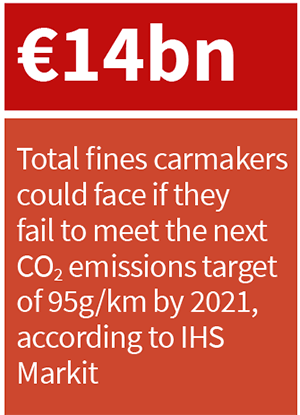 VW has interrupted production at Wolfsburg in the third quarter and is only making vehicles that meet the new standards.
VW has interrupted production at Wolfsburg in the third quarter and is only making vehicles that meet the new standards.
Other carmakers are also facing additional downtime while switching to WLTP and, according to emergency logistics provider Evolution Time Critical, tier one suppliers are expediting shipments using premium freight in order to meet the rising demand for components that enable reduced emissions and greater efficiency under the new standards.
“Suppliers of components that are vital to achieving reduced emissions under WLTP procedures have experienced an increased demand and an expectation for reduced lead times as manufacturers battle to meet new legislation and consumers are physically buying more gasoline-powered cars,” says Evolution Time Critical MD, Brad Brennan.
“This has led to a perfect storm scenario whereby manufacturers are facing two separate requirements for increased short-term capacity: preparation for new legislation and the growing consumer demand for a non-diesel powertrain.”
Impact on profitsThe impact on the supply chain has been felt elsewhere in Germany. BMW reported in September that the industry-wide shift to the new WLTP test cycle had led to “significant supply distortions” in several European markets and “unexpected intense competition”.
Taken together with international trade conflicts, which BMW says were aggravating the market and feeding uncertainty, the carmaker saw an impact on group profits in the third and fourth quarters, and has lowered its revenue expectations for the 2018 financial year. Earnings before tax are now expected to equate to around 7% of revenue, rather than the 8-10% previously forecast.
The company says it is responding to the supply distortions by reducing volume output, though it would not provide any figures on the number of units affected.
Supply distortions more generally can be seen in passenger car registrations across the EU. Demand for new cars across the member states grew by 10.5% to 1.3m in July, while in August, usually the slowest sales month of the year, they jumped by 31.2%, with 1.1m registered, according to figures from the European Automobile Manufacturers Association (ACEA).
[mpu_ad]The association said the most likely explanation for the exceptional growth was the introduction of the WLTP test and the fact that certain carmakers had offered pre-WLTP vehicles at “extremely attractive prices”. Strong sales over the summer months pushed demand up most in Spain (up 14.6%), France (8.9%) and Germany (6.4%); the only market where sales contracted was the UK (down 4.2%).
Analyst IHS Markit notes the impact of “exceptional and temporary pre-registration activity” associated with the move to WLTP as OEMs sought to attract customers by offering incentives and carrying out tactical registrations, including pre-registrations by dealers.
Outbound capacity crunchThat sudden escalation in sales had an impact on finished vehicle logistics providers in Europe, with high levels of congestion reported at terminals and ports. German road transport providers noted a marked increase in volumes throughout July and August, which included incentivised dealer stocks being pushed out. That was followed by a big slump in September.
While stock remains high in the compounds, demand for transport services is now low. Part of this is down to carmakers ‘banking’ vehicles awaiting WLTP approval in compounds. Transport providers are expecting a flood of vehicles to stretch capacity through November and December as those stored volumes hit the market alongside normal production output, however.
BLG Logistics says that over the course of the year, it has seen an increasing impact from the various preparations made by manufacturers on services. “As vehicles now have to move out of the storage facilities, we expect further impacts up to the end of the year,” says a spokesperson for the company. “It is a challenge for the transport industry to provide and manage the necessary capacities for WLTP units alongside the normal production volumes – especially because of the lack of a planning horizon in some cases. We expect the challenges relating to vehicle certification and the influences on transport and handling logistics to continue into next year.”
BLG also says the disruption caused by the WLTP regulations is being compounded by other issues affecting exports from the seaports, including altered tax regulations in Sweden and the correct treatment for the brown marmorated stink bug on shipments for Australia and New Zealand.
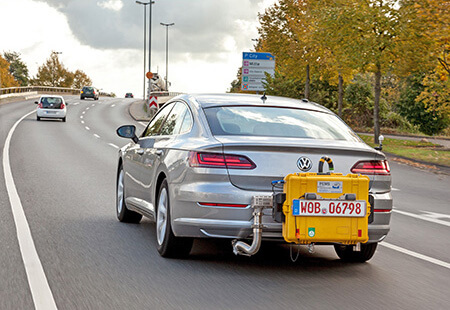
Germany’s DB Cargo, meanwhile, reports high demand for rail wagon capacity, longer lead times on delivery and “sub-optimal use of equipment” which has led to cancellations.
One other factor affecting the trade in vehicles, which will affect engineering manpower and the movement of vehicles, is the announcement by the German government that owners of older diesel vehicles should be able to choose between trade-in incentives and hardware upgrades to comply with new regulations on city driving.
Earlier this year, German legislators ruled that city officials were free to ban older diesel vehicles from their streets to bring air pollution levels into line with EU rules. Owners of models with Euro 4 and Euro 5 emissions standards are being allowed to purchase modern used models rather than just new cars.
Spikes in demandThe other consequence of the pull-forward in production and sales ahead of the WLTP coming into force is that sales will be lower following the September deadline, especially if buyers are attracted to existing registered stock – though as indicated, there could be temporary spikes in outbound movements as vehicles are approved and released from storage.
IHS Markit says this is likely to happen in Germany, where the mass pre-registrations of most VW Group brands have particularly affected results. VW has already said it is introducing some temporary production halts to smooth the testing and compliance process for WLTP, including at its Emden, Wolfsburg and Zwickau factories, with a negative impact on registrations to the end of 2018. For the full year, IHS Markit is forecasting that passenger car registrations will reach 3.35m units, a rise of around 2% year-on-year.
The analyst also points to the impact of WLTP in Spain, where year-on-year company purchases of vehicles jumped 85.7% in August to 43,730 units. Private customers bought 57,457 units, while rental fleets took a further 6,505 units.
Dealers also made around 20,000 self-registrations during the month, according to IHS Markit. The company anticipates that registration growth this year will be less than in 2017, but still up by around 7% to 1.32m units.
"It is a challenge for the transport industry to provide and manage the necessary capacities for WLTP units alongside the normal production volumes." - Spokesperson, BLG Logistics
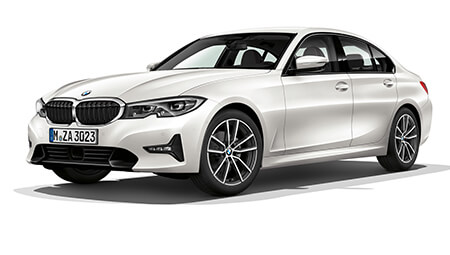 Carmakers have been working hard against a stringent deadline to meet the demands of the new WLTP legislation.
Carmakers have been working hard against a stringent deadline to meet the demands of the new WLTP legislation.
BMW says its first model to receive WLTP type-approval was the current BMW X3 with the 20i and 30i petrol engines. Those vehicles were approved in December last year, but now all petrol and plug-in hybrid models that are available in Europe are WLTP-approved and fitted with a gasoline particulate filter as standard. This has been in place since July this year.
In addition, since March this year, all new BMW diesel models have been equipped with what the OEM described as a highly effective, multi-level emissions treatment system which comprises a NOx storage catalyst and selective catalytic reduction (SCR) technology.
Rival German carmaker Mercedes-Benz says its entire fleet for Europe was already certified for the WLTP standard, and that more than 80% of the models are certified to Euro 6d Temp, one year before that separate emission standard becomes mandatory for all vehicles.
Euro 6c/6d Temp refers to the specific emission rating following the Euro 6 standard introduced in 2014 but which now falls under the Real Driving Emissions (RDE) standard, which covers NOx, particulate matter and all other toxic emissions in road-testing situations (as opposed to the laboratory) and runs alongside WLTP. The RDE standard applies to new vehicle types from September 1 (as WLTP did last year) and will apply to all vehicles from September 1 2019.
BMW says that since July this year, around 190 of its models already fulfilled the Euro 6d-Temp requirements, including petrol and diesel cars plus the BMW i, BMW iPerformance and BMW M vehicles.
“All BMW Group vehicles that can currently be ordered from the factory in Europe are WLTP type-approved with emission norm Euro 6c or Euro 6d-Temp,” says a spokesperson.
Ford also reports being on track to meet regulatory targets, but has seen a significantly higher workload, something exacerbated by the late development of the detailed requirements, especially for the Euro 6d-Temp and new RDE test. However, a spokesperson says that implementation of the rules across Ford passenger cars and light commercial vehicles is almost complete for WLTP.
[related_topics align="right" border="yes"]“While the 2020 CO2 targets are very difficult to meet with the changing rules and diesel market share reducing, we still expect to meet the 2020 regulation,” says Ford’s spokesperson.
The carmaker says its strategy to meet those regulations was based on a broad mix of technologies, including more efficient internal combustion engines, such as the EcoBoost petrol and EcoBlue diesel engines, as well as a range of electrified products.
“Based on this, we are confident we can meet the required target levels,” says the spokesperson. “In this context, Ford is investing $11 billion globally and adding 40 new electrified vehicles to our portfolio by 2022. In Europe, we will introduce new plug-in hybrid, hybrid electric and full electric vehicles.”
Groupe PSA has also confirmed that all Peugeot, Citroën, DS, Opel and Vauxhall passenger cars are approved under the test procedure. The company said the next step would be the future Euro 6d-Temp standard.
Topics
- ACEA
- BLG Logistics
- BMW
- BMW
- Citroen
- DB Cargo
- Denmark
- DS
- ECG
- Emergency logistics
- Europe
- European Automobile Manufacturers Association
- Evolution Time Critical
- features
- Finished Vehicle Logistics
- Ford
- Ford
- France
- Germany
- Groupe PSA
- IHS Markit
- Inbound Logistics
- Italy
- LMC Automotive
- Netherlands
- Norway
- OEMs
- Opel
- Peugeot
- Policy and regulation
- Road
- Spain
- Stellantis
- Suppliers
- United Kingdom
- vauxhall
- Volkswagen
- VW

























![Global[1]](https://d3n5uof8vony13.cloudfront.net/Pictures/web/a/d/s/global1_726550.svgz)












